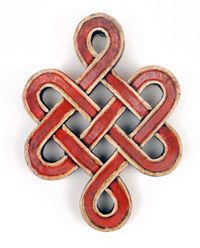Symmetry and Celtic Knots Exploration
Objective: Learn the Rosette symmetry groups: cyclic and dihedral groups. Draw some Celtic knots.
Materials needed: Graph paper is helpful for drawing knots.
Rosette groups
The collection of symmetries of a figure (the markings) is called the symmetry group of the figure.
Symmetry groups for finite figures are called Rosette groups. They come in two types, depending on whether the figure has reflectional symmetry.
- If there is reflectional symmetry, then the symmetry group is called a dihedral group, abbreviated 'D'.
- If there is no reflectional symmetry, then the symmetry group is called a cyclic group, abbreviated 'C'.
Next, find the highest order of rotational symmetry in the figure. This number is appended to the ‘D’ or ‘C' to form the symmetry group name.
For example, this Celtic knot has no reflection symmetry, so it is cyclic. It has 3-fold (order 3) rotational symmetry, so it has symmetry group C3.
| Celtic knot with C3 symmetry |
|---|
 |
Identify symmetry groups
Determine the Rosette symmetry group for each of these patterns:
-
A: 
B: 
C: 
D: 
E: 
F: 
-
These are examples of traditional Celtic knotwork. Keep an eye on the over and under crossings when looking for reflection symmetry.
A: 
B: 
C: 
D: 
E: 
F: 
Draw some knots

- Follow the instructions at Celtic Knotwork: the Ultimate Tutorial to draw the "endless knot", a Buddhist symbol used in the Ming dynasty.
- Draw more knots, using some of the graphs on the Exercises page
If you would like to take this exploration further, continue with the Ultimate Tutorial, and explore the Draw Your Own Celtic Knotwork page. You could also download KnotsBag by Hypatiasoft, a professional grade program for creating computer generated knotwork. The demo version is usable and free.
Handin: The symmetry groups of the patterns. Pictures of knots.
